The HTC One (M8) Review
by Anand Lal Shimpi & Joshua Ho on March 26, 2014 7:00 PM EST- Posted in
- Smartphones
- HTC
- Mobile
- HTC One
Battery Life
The new One features an integrated 3.8V 2600mAh battery (9.88 Wh), a 13% increase in capacity compared to the previous model. The battery comparison isn’t that simple however. The M8 has a larger display (5” vs 4.7”) but it also has a higher performing and more power efficient SoC (Snapdragon 801 vs. 600). To find out how the new One stacks up against its predecessor, we turn to a mix of old and new battery life tests to help better characterize the device.
We’ll start with our standard browser based battery life tests. Keep in mind here these tests are as much about replicating a particular CPU profile as they are about loading specific web pages in order.
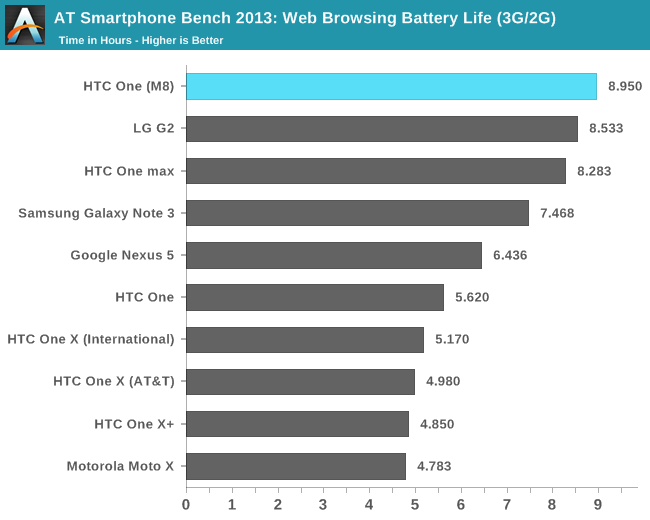
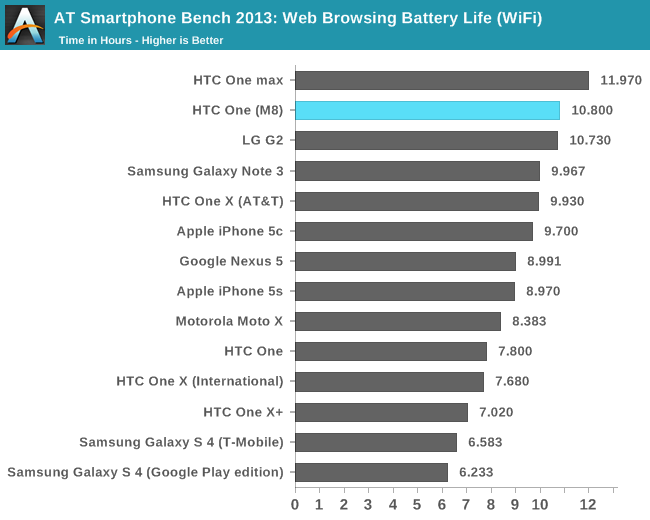
We saw a substantial gain in battery life with Snapdragon 800, and 801 extends that even further. For the same, relatively light (yet constant) workload, the M8 improves battery life over the M7 by as much as 71%. On WiFi the advantage drops to only 38%, but we’re still talking about absolutely huge generational gains.
A constant workload is only one part of the story though. More often than not, when you’re faced with faster compute you end up doing more. To see what the other extreme of battery life looks like I turned to two canned tests: BaseMark OS II and GFXBench 3.0.
I ran both of these tests under the same controlled conditions we always use, with all displays calibrated to 200 nits. BaseMark OS II runs through a bunch of CPU and storage benchmarks (basically the same tests used for the BaseMark OS II system and memory tests), as fast as possible, until the battery dies.
I like this benchmark as it gives us an indication of worst case battery life if you’re absolutely hammering the CPU (and storage) relentlessly.
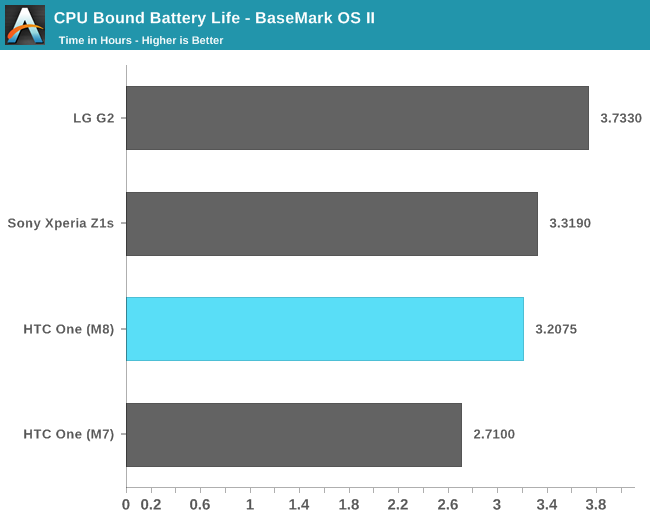
Despite the faster CPU cores, the M8’s battery life actually goes up compared to M7. Here we’re really seeing the benefits of 801’s updated 28nm HPm process compared to the Snapdragon 600’s 28nm LP process.
GFXBench provides a similar test, with effectively uncapped performance (on today’s devices at least since we’re not hitting v-sync limits), but stressing the GPU instead of the CPU. Here we’re running the T-Rex HD benchmark, onscreen, until the battery dies.

This is the first and only test we’ve got here that shows a regression in battery life compared to M7. The M8 loses about 6% of runtime compared to the M7, despite having a larger battery. Now look at what happens if we look at performance at the end of the run:
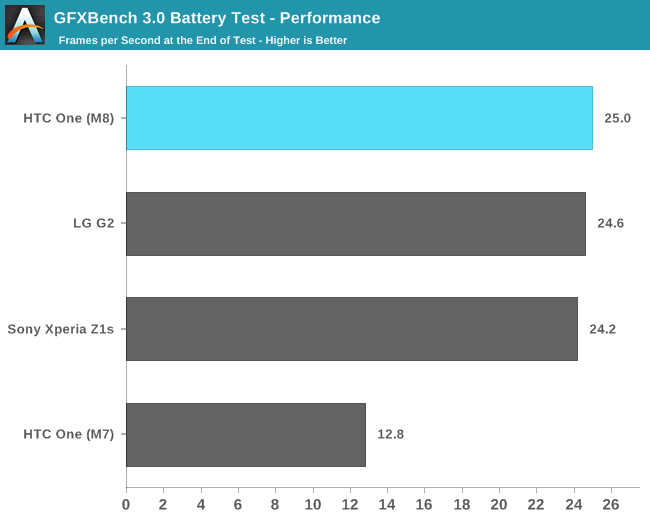
Now the M8’s battery life regression doesn’t look so bad. You give up 6% of runtime but you get almost twice the performance compared to M7. Snapdragon 801 is just a huge upgrade compared to 600.
Charge Time
The M8 features a Qualcomm Quick Charge 2.0 enabled PMIC, which enables faster battery charge times through higher voltage charging. Unfortunately the in-box wall adapter is only Quick Charge 1.5 compliant so you'll only pull 7.5W from the wall. HTC expects to offer a Quick Charge 2.0 compliant power adapter later this year.
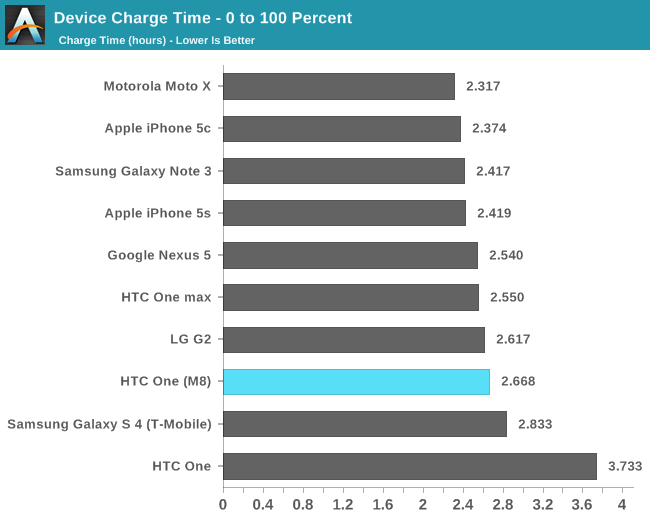
The M8's charge time is a bit slow compared to what we've seen from other devices with larger batteries.










222 Comments
View All Comments
berantle - Friday, March 28, 2014 - link
@Death666Angel, it is not a stupid argument. It is a rational reasonable argument.Fundamentally, it is a phone first and whatever else second. Yes, it is capable of other things but it cannot fully replace what other purpose-specific devices do better. Taking into account the size, form factor and the practical realities of smartphones, it is actually pretty foolish to expect that these fully replace the proper devices for it.
The main point about the camera as stated ad nauseum is the camera's resolution is sufficient for what many people use the photos taken from it - i.e. post onto social websites and blogs, and view them on their 1080p (1920x1080) Full HD TV. The 4MP resolution of the HTC One (both M7 and M8) camera equates to 2688 x 1520 images at 16:9 ratio. This size provides more than enough detail for 1080p Full HD TVs that are very common nowadays. Posting on Facebook, Google+, Instagram, Snapchat, etc, the image sizes shown on screen rarely, if ever, go as large as 1920x1080.
Good photos are rarely just about how detailed it shots. It's about picture composition/framing, quality of lenses and proper focusing, and a basic understanding and proper use of photography technicalities. If you're a crap photographer, having a higher number of pixels only means you're likely to be taking crap photos that have more detail.
That all said, personally, 4MP (2688x1520) pictures are at the lower end of my requirements. It would be nice to have a sensor of more 2-micrometer pixels than 4MP. As it is, the 4MP picture resolution of the HTC One camera is adequate for my needs.
Thermalzeal - Friday, March 28, 2014 - link
I don't think it's a broken record. While photo's look similar on a phone's display, they certainly differ in quality when viewed on a higher DPI display. You are right that there is a small audience that appreciates this, but this is a high end product to top off the premium tier of HTC phones. I like the concept of the dual camera, but it would have been nice to get at least a 12MP sensor since they are not really cost prohibitive.Also in the end, you can always down sample a photo, but in the future where bazillionK resolution is the standard, these photo's will look like your mom and dad's black and whites.
evonitzer - Saturday, March 29, 2014 - link
"I like the concept of the dual camera, but it would have been nice to get at least a 12MP sensor since they are not really cost prohibitive."But at what cost in performance? Low light performance will suffer. I do not understand people's difficulty in this minor complexity. The resolution is good enough, and enables greater performance in low light. Daylight shots will lack resolution. We do not need to boil it down any further to "this camera is crap" or "this camera is great". This camera does exactly what it is designed to do and it is up to shoppers to decide if it is right for them.
dimsum888 - Saturday, March 29, 2014 - link
compared to other flagship phones it doesn't perform well. at its price point it is expected all features are comparable to other high end phones.jospoortvliet - Sunday, March 30, 2014 - link
No, compared to other phones it does worse at still pictures with outside day light and better at moving picks and at night. So there is a choice: if you want to take pics inside orat night or of moving objects, the HTC one is best. If you take pics of static objects in good lightning conditions, buy another phone. I know why I prefer my HTC, which makes the better pics in 90% of relevant (for me) circumstances but ymmv.notposting - Monday, March 31, 2014 - link
Or get one of the Lumia's which take better pics both outdoors, indoors, good light, no light, have OIS, have the resolution to allow cropping, some allow for saving a copy in RAW.Between the Note 3, S4/S5, iPhone 5S, Lumia 92x/1020, LG G2, and the Sony lineup, there is basically little reason to choose the HTC if the camera is at all important to you.
augustofretes - Monday, March 31, 2014 - link
The resolution isn't good enough. The detail capture is obscenely poor. People zoom-in their images to see their friends and stuffs in the picture you know? While I agree that 12MP is not really necessary, 8MP + OIS are way a better choice than the nonsense of 4MP + secondary sensor for gimmicky procedures.Blown503 - Monday, March 31, 2014 - link
5 megapixels is an 8x10 picture on paper, 8 megapixels is a 16x20 picture on printed paper. The are printed @ 300 dpi.Chaser - Thursday, April 10, 2014 - link
I've owned the HTC One M7 and if its one area I was disappointed in was its versatility as a point and shoot. Yes the low light level is very good but with larger scale more distance "scenic" outdoor photos there is a difference with the high pixel phone cams. So yes, while a photo of a flower pot on a table may not look "noticeably different" the quality of even smartphone cams vary. I know because I go through flagship smartphones at least once a year sometimes sooner and I use their cameras frequently as I have no desire to carry around an extra camera.Let me make another distinction. If you do take a photo and later desire to crop and resize that photo (and post it on social media for example) the higher pixel cameras won't lose detail like the lower pixels cameras such as my former HTC One would. So enough with the "broken record" about pixels not mattering. I can assure you they do. Even smart phone camera image quality and versatility has improved significantly since two years ago. I sold my HTC One because I was disappointed with it's overall camera quality. I am much happier with my new LG G2's higher pixel camera.
perpetualdark - Wednesday, April 2, 2014 - link
While I agree that the HTC One camera is good enough and even better than other phones in certain situations (ie low light), the megapixel argument does hold water. Unless every picture you take is at standard zoom, the number of pixels in a smartphone is very important. This is NOT a camera with a physical zoom lens on it, so zoom is purely a factor of megapixels. The more pixels you have, the more you can zoom in.Keep in mind, every other camera on smartphones has a smaller lens aperture though, so while you can zoom way in with higher megapixels, you have to have longer exposure to get the same amount of light to the sensor to get the same picture quality, and again the lower the ambient light, the worse the picture. In well lit scenes that are fairly static, an 8 or 16 megapixel camera will be able to zoom way in and get a great picture that is still high resolution even on a 1080p television or monitor. The 4mp might be better in low light and might take great pictures at no zoom, but it cannot touch the zoom capabilities of the higher megapixel cameras. Not without a physical zoom lense, and you aren't going to find that in a smartphone.
Bottom line is that if you like to take a lot of pictures where you need to zoom in, and don't want to always be carrying around a professional grade camera, this isn't the phone for you. And for crying out loud, if you are going to make an argument, at least make a valid one..